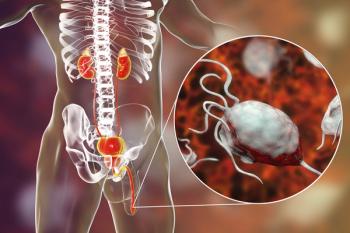
- ONCOLOGY Vol 14 No 4
- Volume 14
- Issue 4
Adjuvant Therapy Improves Survival in Patients With Locally Advanced Prostate Cancer
Hormonal therapy with the goserelin acetate implant (Zoladex) significantly increases overall survival rates in patients with locally advanced prostate cancer when administered at the onset of conventional external irradiation and continued for 3 years.
Hormonal therapy with the goserelin acetate implant (Zoladex) significantly increases overall survival rates in patients with locally advanced prostate cancer when administered at the onset of conventional external irradiation and continued for 3 years. Results of the study, conducted by the European Organization for Research and Treatment of Cancer (EORTC) Radiotherapy Cooperative Group, were presented at the annual meeting of the American Society for Therapeutic Radiology and Oncology (ASTRO) in San Antonio, Texas.
In addition to the increase in overall survival rates, disease-free survival rates also increased significantly in the patients treated with goserelin acetate implant plus radiotherapy when compared to the group given radiotherapy alone.
The results from this study should change the way that prostate cancer is treated, said Michel Bolla, MD, head of radiotherapy at the Hôpital Albert Michallon, in France, and president of the radiotherapy group of the EORTC. The addition of goserelin acetate implant to standard radiotherapy for locally advanced prostate cancer significantly improved survival rates of patients and could save lives. While many clinicians already combine these two treatment options, these data confirm the value of this approach as routine.
Study Methods and Results
From 1987 to 1995, 415 patients under the age of 81 years (median age, 71 years) with locally advanced prostate cancer were randomly allocated between the two arms of the study. All patients received standard pelvic radiotherapy at the start of the trial, but half of the patients also received a monthly, 3.6-mg subcutaneous injection of the goserelin acetate implant beginning the first day of radiation that was continued for a period of 3 years. Patients in the combined treatment group also received 150 mg/d of cyproterone acetate for 1 full month, starting 1 week before the first injection of goserelin.
The addition of the goserelin acetate implant significantly improved the 5-year overall survival rate from 62% to 78% (P < .001). Over the 5-year period, clinical disease-free survival was also significantly increased (from 40% to 75%; P < .001), as was local control (from 79% to 97%; P < .001). The median follow-up was 61 months.
Articles in this issue
over 25 years ago
Dr. Susan Love Launches Women’s Health Web Siteover 25 years ago
Thalidomide Active in Advanced Multiple Myelomaover 25 years ago
Bexxar Plus Fludarabine Effective First-Line Therapy for NHLover 25 years ago
Results of Lymphoma Vaccine Study Prompt Large- Scale TrialNewsletter
Stay up to date on recent advances in the multidisciplinary approach to cancer.


















































































